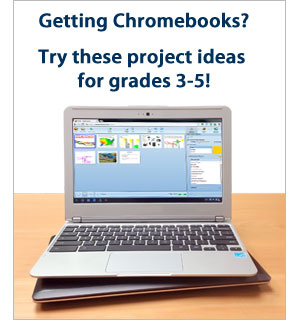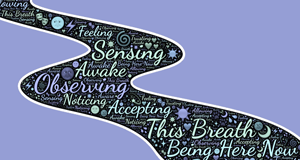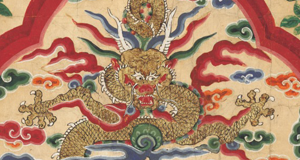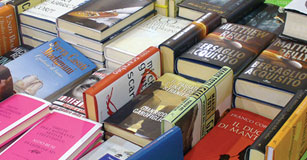Postcards from the Past
Students will create fictional postcards to show how a single person viewed the past. Students will then analyze the range of perspectives in all class postcards to gain a deeper understanding of history.
Apps: Wixie®

Task
In this project, students will use historical empathy to create a series of fictional postcards that share the experience and perspective of a single person living during a historic event or time. Students will then compare, analyze and discuss the range of perspectives demonstrated in their class’s collection of postcards.
Engage
Explore a time period, historic event, or culture from multiple perspectives through a combination of primary and secondary sources, field trips, visits with experts, and classroom discussions. As they work to complete their historical research, ask students to think about the different perspectives of people affected.
Based on their knowledge of the meaning of the word empathy, ask your students if they can guess what historical empathy means. Have them share their ideas on paper as they enter class, submit as homework, or share in a class discussion. Collect and post responses anonymously on your whiteboard.
Work together to analyze their responses and develop a collective definition of historical empathy. Clarify thinking so that students understand that historical empathy is making a conscious attempt to see and experience the world through another person’s eyes, not sharing the same viewpoint or projecting their feelings onto someone from the past.
Let students know that they will share their learning about the time, culture, or events you are studying through fictional postcards they will send as a person experiencing those events.
Share examples of historical postcards with your students. You can find these at antique stores, print and laminate examples you find online, or explore samples from Library of Congress, such as this one from a 1941 trip to Washington, DC.

Have students share things they noticed about the postcards. You might prompt them to share similarities and differences. While it is often hard to read the handwriting, ask students to postulate more about the person writing, based on the content and style of their message.
Create
Have students choose a specific person, or create a fictional character (persona), they will use to share a first-person perspective of the time or place you are studying.
Have students use a cluster diagram, or an organizer like a 5W's chart, to describe this person, or persona, answering questions like:
- What is this person’s gender, age, race, or ethnicity?
- What sort of education does this person have?
- What economic or social class are they in?
- What political views do they hold?
- What do they aspire to? What do they fear?
Have students revisit primary, secondary and instructional resources about the time and place they are studying. Ask students to add additional bubbles, or clusters, to each area to describe how each of these characteristics makes this persona feel or think about events around them.
Create a Graphic Organizer
Need a thought web, timeline, flowchart, or other graphic organizer for a lesson?
CreateWhen their character/persona analysis is complete, students should brainstorm three people who will be the recipients of their postcards, such as friends, family members, neighbors, or other people in the community.
Students should brainstorm content ideas for three different postcards, including the cover images and text message. Students should use these ideas to write and draw a rough draft that they can share with a peer for feedback and suggestions. Students should then make appropriate edits and changes to the text before creating the final postcard.
Have students create their postcards using pencil and paper or a digital tool that allows them to combine images and text. If students are using Wixie, they can choose from several different postcard templates or create their postcards from scratch and print at postcard size.
Students can type their message to the recipient, and find pictures for the front of their postcard through a Web search or by using images from Pics4Learning. You can also encourage budding artists to use paint tools and clip art to create original artwork for the front of their postcards. Postcards should also include text indicating the date and location. Adding a stamp is another fun way to incorporate cultural information.
Share
Have students read their postcards to the rest of the class. You may even want to encourage them to dress according to their persona. This is a great way to celebrate their effort and also provides an opportunity for you to see how well they have used historical empathy to understand how that person felt and thought at that time.
Print each student’s set of postcards and add them to a board or display so students can reread and further analyze them. Reading all of the postcards showing the different perspectives of people involved provides students with a deeper understanding of the past.
Pair students together and ask them to complete a Venn diagram that compares the different perspectives shared in their postcards.
Have each pair share their findings with the rest of the class and work as a whole group to identify differences in the viewpoints shared in all of the postcards. A historian from a local museum would be a great moderator for this discussion.
Discuss why these viewpoints may be different. While you can evaluate student’s verbal responses to identify misconceptions, exploring multiple perspectives is where the deep learning occurs. To better assess this learning, ask students to respond in writing to a prompt like, “What do different perspectives teach us about this time/event/culture?”
Be sure students understand that they need to back up their ideas with specific evidence from the postcards and original instructional materials to justify their answers.
Assessment
Creating and writing postcards from another person’s point of view provides students with a powerful opportunity to explore perspective and engage with events that happened in the past. You can use student’s organizers describing their persona as well as the writing on their individual postcards to evaluate their ability to utilize historical empathy to better connect with events in the past and how people experienced them.
The small amount of space available for text requires students to summarize information and be deliberate and thoughtful while choosing words and images to express their ideas, so you may want to include main ideas and word choice as part of your checklist or rubric assessment.
By creating a fictional primary source document, students have an opportunity to explore how an individual’s perspective and the audience for their work impacts how one should read and utilize information found in primary source documents. Ask students how the process of creating a postcard changes the way they will view and read primary source postcards in the future.
The deepest historical learning will not happen during the individual student creation of the postcards, but during student’s analysis of the multiple perspectives shown through the entire class collection of postcards.
As students read and analyze their peer’s postcards, challenge them to identify the differences in their content and postulate why perspectives are different (power, economics, social position). Use their verbal and written responses to the differences in perspective to evaluate their understanding of events in the past.
To support student learning, during both the process of creating individual postcards and analyzing the range of perspectives showcased in all of the postcards, conduct regular formative assessments during the research, writing, and publishing process. Work to clarify thinking and comprehension through one-on-one or group discussions. You can also review student research notes, character choice, postcard images, and rough drafts of writing to evaluate student progress.
Resources
Tyson Retz. Empathy and History: Historical Understanding in Re-enactment, Hermeneutics and Education. ISBN: 785339192
Library of Congress: Teaching Inquiry with Primary Sources
Art History Archive: History of Postcards
Standards
C3 Framework for Social Studies State Standards
D2.History.6.3-5
Describe how people’s perspectives shaped the historical the historical sources they created.
D2.History.4.6-8
Analyze multiple factors that influenced the perspectives of people during different historical eras.
D2.History.11.3-5
Infer the intended audience and purpose of a historical source from information within the source itself.
D2.History.13.3-5
Use information about a historical source, including the maker, date, place of origin, intended audience, and purpose to judge the extent to which the source is useful for studying a particular topic.
Common Core State Standards for English Language Arts:
College and Career Ready Anchor Standard.W.4
Produce clear and coherent writing in which the development, organization, and style are appropriate to task, purpose, and audience.
CCSS.ELA-LITERACY.RH.6-8.2
Determine the central ideas or information of a primary or secondary source; provide an accurate summary of the source distinct from prior knowledge or opinions.
CCSS.ELA-LITERACY.RH.6-8.6
Identify aspects of a text that reveal an author's point of view or purpose (e.g., loaded language, inclusion or avoidance of particular facts).
ISTE Standards for Students:
3. Knowledge Constructor
Students critically curate a variety of resources using digital tools to construct knowledge, produce creative artifacts and make meaningful learning experiences for themselves and others. Students:
a. plan and employ effective research strategies to locate information and other resources for their intellectual or creative pursuits.
b. evaluate the accuracy, perspective, credibility and relevance of information, media, data or other resources.
c. curate information from digital resources using a variety of tools and methods to create collections of artifacts that demonstrate meaningful connections or conclusions.
6. Creative Communicator
Students communicate clearly and express themselves creatively for a variety of purposes using the platforms, tools, styles, formats and digital media appropriate to their goals. Students:
a. choose the appropriate platforms and tools for meeting the desired objectives of their creation or communication.
b. create original works or responsibly repurpose or remix digital resources into new creations.
d. publish or present content that customizes the message and medium for their intended audiences.









